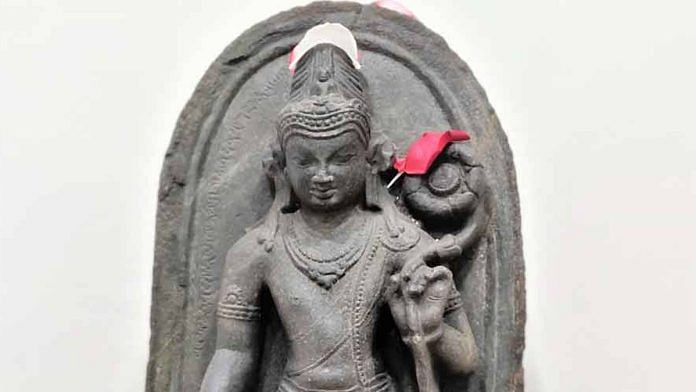New Delhi: According to some estimates, India has lost roughly 10,000 major works of art every decade since the 1950s and cases of allegedly stolen antiquities being smuggled into international markets and sold by foreign dealers and auction houses at steep prices continue to be reported.
Between 1992 and 2017, some 4,408 items were allegedly stolen from monuments across India, but only a third were intercepted by the police, said a report by the Economic Advisory Council to the Prime Minister last September.
The rest are feared to have been illegally trafficked abroad.
Governments in the US, UK and Australia have in the past five to 10 years returned stolen art to India, but these are usually part of criminal investigations into art crooks. On one occasion, in January this year, a UK museum proactively returned seven Indian antiquities believed to have been stolen during the 19th Century.
While provenances — a certificate of authenticity that establishes the chain of ownership of an artefact — are important, there have also been calls for the Indian government to enter into formal bilateral agreements to inhibit the entry of illicit art into foreign countries. Stopping looted art at the border entails a much easier repatriation process than tracking down art that has already entered a foreign country and passed through several hands, say experts.
During his visit to the US in June, Prime Minister Narendra Modi and US President Joe Biden vowed to work “quickly” toward a Cultural Property Agreement — exactly the kind of thing that art detectives like S. Vijay Kumar have been clamouring for.
Kumar is the co-founder of India Pride Project, a voluntary group that tracks down stolen Indian art.
“We have found most of the items returned to India linked to illicit trafficking by [convicted art dealer] Subhash Kapoor,” lawyers Roshnek Dhalla and Dnyaneshwari Chincholikar told ThePrint.
Currently in jail, Kapoor was notorious for selling stolen artefacts to the US and other countries. In 2021, the US returned 248 items, valued at $15 million, to India, all of which were linked to Kapoor.
Also Read: Ancient statues, scroll, portraits — Full list of 29 antiquities Australia returned to India
‘US home to 30-40% of looted Indian art’
A Cultural Property Agreement restricts illegal art imports, and enhances cooperation between law enforcement agencies of two countries in stopping illegal art at border points. So far, 25 countries have entered into such agreements with the US, including China, Egypt, Cambodia and Nigeria.
According to Kumar, about 30-40 per cent of looted Indian art lands up in the US.
Therefore, an agreement like this could help nab smaller antiquities that are often sold under the radar, such as ancient chariot parts, pillar fragments, coins, etc.
“The agreement can help catch small-ticket antiquities that range from $5,000 to $20,000 in worth. It can lead to more criminal prosecutions and help dismantle the smuggling network,” he told ThePrint.
Following a Cultural Property Agreement, the burden of proof will fall on the exporter, explained Kumar.
“Once an exported item reaches a US border point, law enforcement will inspect it. If there is suspicion that it is illicit, Indian authorities will be contacted and a joint investigation may follow,” he said.
Cultural Property Agreements, usually renewed every five years, include a “Designated List”. This list specifies archaeological material that will face import restrictions at US border points.
For example, China’s “Designated List”, seen by ThePrint, covers the pre-historic period until the Tang Dynasty, and any art that is at least 250 years old. Egypt’s list covers the pre-historic period, up to 1750 AD, which may include stone, basketry, semi-precious stones, bone, ivory, etc.
India will likely have a list too once it enters into such an agreement with the US.
Currently, art returned by the US to India is usually linked to criminal investigations, but at times, US federal agencies coordinate with art enthusiasts like Kumar to identify items.
For example, Kumar recalled working with the US federal agencies in 2022 to help repatriate a 500-year-old Hanuman idol which was auctioned at renowned auction house Christie’s in 2015 and acquired by a buyer in Australia.
The importance of provenances
It has been estimated that when Cambodia entered into a Cultural Property Agreement with the US in 2003, Khmer antiquities auctioned at New York-based Sotheby’s fell by 80 per cent.
A 2011 study by archaeologist Tess Davis claims that over 70 per cent of all Cambodian antiquities auctioned by Sotheby’s since 1988 had either no published ownership history, or had “weak” provenances — a certificate of authenticity that establishes the chain of ownership of an artefact.
This suggests that large auction houses have very often sold looted art from across the world without proper certification.
Provenances are key to cracking down on illicit art trade and some art crooks like Subhash Kapoor have gone as far as to forge these documents, say experts.
It all boils down to the 1970 UNESCO Convention — the first international agreement aimed at tackling the trade of stolen cultural property. India, the US and many others have ratified this treaty.
Under this, the international community agrees that any antiquity exported before 1970 is valid. This is why a pre-1970 provenance is key to any sale of art.
However, even if an art dealer abroad holds a pre-1970 provenance for an item, the Indian government has the authority to seize it.
The Operational Guidelines of the UNESCO convention state: “The 1970 UNESCO Convention…does (not) limit the right of a state or another person to make a claim for repatriation of cultural property that was wrongfully exported before 1970.”
(Edited by Nida Fatima Siddiqui)
Also Read: How unique ‘Bazaar paintings’ fuelled trade in colonial India



